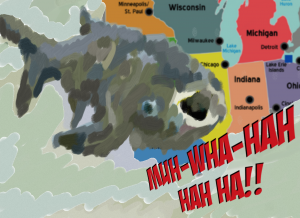The Mississippi River watershed a post-aCARPalypse world, the Great Lakes fear Carpmageddon!
Verb: zerg (third-person singular simple present zergs, present participle zerging, simple past and past participle zerged)
(slang, video games, strategy games) To attack an opponent with a large swarm of units before they have been able to build sufficient defenses.
From the game StarCraft (1998), in which the easily mass-produced Zerg units encourage such a strategy.
the aCARPalypse has come. The verb to zerg, originally coined as “to zerg rush” with the quickly and easily mass-produced Zerg soldiers in the PC strategy game StarCraft, fits perfectly the Asian carp invasion of North America’s freshwater ecosystems. No invasive species in recent memory is invadier than Asian carp—they have zerged up the Mississippi River and its tributaries—swarming everything with unbelievably-fast mass-reproducing carp, crushing biodiversity before our civilization is “able to build sufficient defenses.”
A comparison with a zombie apocalypse, or zompocalypse, is apt too, as everything in an ecosystem the Asian carp touch rapidly become all Asian carp, all the time. This brings to mind the old adage “90% of everything is crap carp,” though it has long been even carpier than that…
…according to one study cited in the Asian Carp II Seventh Circuit case, 95% of everything is carp. (“A fish kill conducted near St. Louis in 1999 showed that the Asian carp constituted over 95% of the biomass in the Mississippi at that place and time.”)
Source: (Theodore) Sturgeon’s Law, as applied to the invasive fish species problem – Eugene Volokh’s law blog
Think how overwhelming the zerg rush of carp must be now, 15 years after that study!

Like most invasive species, and old monster movies, the monster was created (the alien invader carp introduced) via man’s folly and ignorance of potential unintended consequences. Asian carp, being super aggressive bottom-feeders, were imported to om-nom U.S. fish farms clean beginning in the 1970s, but with seasonal flooding chauffeuring fish over barriers, it was only a matter of time before the Asian carp escaped sequestered aquaculture and swarmed the natural freshwater ecosystems nearby!
Bighead and silver carp have been the most problematic of the invasive Asian carp species in the U.S., filtering plankton from the water, robbing native species of food and living space. And because of their bottom-feeding habits, they are difficult to catch with normal angling methods, so obvious counter-measures (giant fish fry) have been ineffective, though fishing efforts continue …the Natural Resources Defense Council has its Eat An Invasive Today! campaign.
It’s an ACARPALYPSE where everything becomes Asian carp, and our system of multiple state jurisdictions, state and federal regulatory agencies and “other agency’s job” inaction vs. the uncomplicated carp zerg rush upstream has been a total failure. Our gov’t has been outwitted by carp. Our system’s inability to mount a defense,

stop or slow the spread of one-fish-group supremacy (ecosystems becoming carp monocultures or carptocracies) has led to lawsuits by the upstream states and other parties who have LOTS to lose economically if/when the carp wave crashes into their ecosystems and wipes out biodiversity, wrecks local fisheries, implodes fishing economies and the dollars from angler tourism, fishing tournaments and all the fishermen there due to rich supplies of diverse indigenous fish would be gone.
The upstream states, especially the Great Lakes states so dependent on their native fish species, have understandably been pushing hard for the pertinent agencies to build defenses to protect the Lakes, specifically advocating “complete hydrological separation” of the Great Lakes and the Mississippi River basin AKA closing the key link to Lake Michigan, the Chicago Area Waterway System (CAWS).
Michigan, Minnesota, Ohio, Pennsylvania, Wisconsin, and affected indigenous tribes, all bordering the Great Lakes, filed a lawsuit against the U.S. Army Corps of Engineers who are responsible for building defenses and the Metropolitan Water Reclamation District of Greater Chicago who own the CAWS.
In the Asian carp I case, the Seventh Circuit Court of Appeals in Chicago upheld the prior denials of the pro-hydrological separation states’ claim vs. the CAWS operators and Army Corps of Engineers. But while rejecting the plaintiffs’ claim because it held that the CAWS was being operated in a sufficiently anti-carp manner, the Court nonetheless ruled against the federales’ claim of sovereign immunity and their argument that federal agencies could never create a public nuisance because they have something like the “divine right of kings” and therefore automatically serve the public good. The three judge panel acknowledged that the Corps acts on Congress’ orders but refused to immunize them from future public nuisance liability.
July 14, 2014, the Seventh Circuit Court ruled again on the suit against the Corps of Engineers and CAWS operators in what’s being called the Asian carp II case. In this court opinion, the Appeals panel again upheld earlier denials of the Great Lakes states’ plea because of actively ongoing efforts to prevent the carp from getting through the CAWS. But the Court also (finally) ruled on the legal question of “public nuisance” definitively, holding that YES, federal agencies can create a “public nuisance.” I’m not entirely clear on the exact definition and limits of “public nuisance” in its legal sense as used here, but this concept could be an important precedent on which future cases might be built. As someone who was once a plaintiff against the state, I understand that the precedent of the federal gov’t itself causing nuisances and being held liable could be super important, though theoretical here.
The Seventh Circuit also rejected the feds’ rather… unique argument that the nuisance was solely carp “acting of their own accord,” and not their fault. That concept of carp as legal actors brought oddities like “Our decision does not depend on the fact that the Asian carp are advancing upstream of their own volition,” into it, not the sort of phrase that one would normally find in a federal court decision.
Ultimately, the Seventh Circuit Court of Appeals’ opinion in Asian carp II reiterated the previous rulings’ reasoning that the gov’t is doing enough to halt the carp from devastating the Great Lakes, but wholly rejected blaming the carp alone. “It is the defendants’ apparent diligence, rather than their claimed helplessness, that is key to our holding today…” the ruling stated.
For more about Asian carp II, and longer excerpts from the opinion, see Federal government action can be a public nuisance, Seventh Circuit holds – Eugene Volokh’s law blog
Competing interests are definitely the biggest barrier to a carp barrier, as shutting down the CAWS would upset the movement of millions of tons of vital shipments of iron ore, coal, grain and other cargo, totaling more than $1.5 billion a year, and contribute to the loss of thousands, perhaps bajillions of jobs. The Chamber of Commerce weighed in with an amicus brief against closing the CAWS, and of course Chicago and the region doesn’t want it closed.
Narrower interests than this have blocked action. The whole Chicagoland regional economy is a heavy player here with lots of clout.

But on the pro-hydrological separation side, there are five other Great Lakes states + the province of Ontario, and Indian tribes, and they have clout too and probably stand to lose even more economically, bazillions in income and countless jobs of multi-state economies, than the pro-defendant interests do if the carpocalypse wipes out the Great Lakes ecosystems. Economic impact on one or both sides of the dispute is a certainty because of inaction instead of action on the issue of invasive Asian carp in prior decades!
Carp jokes aside, I think that this long-standing dilemma raises deeply important questions about the American system itself and the sclerosis and decay afflicting the system:
- when there are competing interests, who decides?
- if the Judicial branch can’t force a decision on long-view ecological crises, who can?
- what is the proper presidential role in the event of invasive species catastrophes?
- why do none of the legislative solutions proposed in Congress pass?
At this late date, the CAWS may be a moot point as carp babies are evidently immune to the electric barriers and the carp have established footholds beyond the canal.
But the challenge of Asian carp and other invasive species, and the larger issue of good environmental stewardship and protecting our communities from toxins, won’t be going away.
Nick
Recommended resources:
Great Lakes Law: Great Lakes on the brink of Asian carp invasion thanks to “monumental government screwup” – great overview of the backstory
Fish Out of Water – The New Yorker – includes a wonderful Ralph Steadman illustration of leaping Asian carp
Final ep in the documentary mini-series Constitution USA – exploring the carpocalypse and other challenges to our constitutional system of divided powers.
